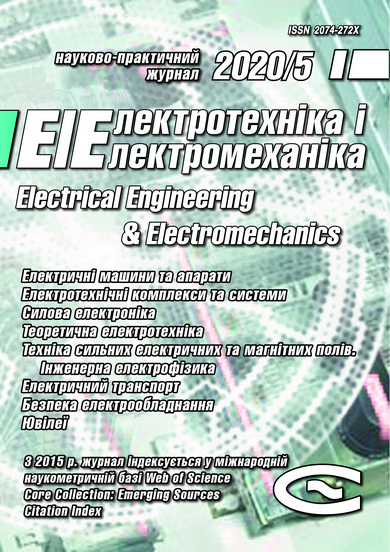MAGNETIC FIELD NORMALIZATION IN RESIDENTIAL BUILDING LOCATED NEAR OVERHEAD LINE BY GRID SHIELD
DOI:
https://doi.org/10.20998/2074-272X.2020.5.06Keywords:
magnetic field, shielding, overhead line, right-of-way, reference levelAbstract
This paper deals with the magnetic field mitigation of 110 kV trefoil single-circuit and double-circuit overhead lines by grid shields. The shields under study are made of aluminum conductors connected in parallel. These shields are mounted on the walls of the building. We study the efficiencies of plane and U-shaped grid shields as the dependence from the quantity of metal. As the result, we show that the plane grid shield does not supply the required efficiency of magnetic field mitigation in corner areas of the building. At the same time, the U-shaped grid shield having equivalent quantity of metal allows to mitigate the magnetic field to the reference level 0.5 µT in more than 97 % part of the building.References
Pelevin D.Ye. The methods of reducing of the magnetic fields of overhead power lines outside security zones. Technical Electrodynamics, 2014, no. 5, pp. 14-16. (Rus).
Electrical installation regulations. Kharkiv,FortPubl., 2017. 760 p. (Ukr).
Decree of the Cabinet of Ministries of Ukraine dated March 4, 1997 No. 209 «About the statement of Rules of protection of electric networks», edition on April 5, 2017. (Ukr).
Grinchenko V.S. Mitigation of three-phase power line magnetic field by grid electromagnetic shield. Technical Electrodynamics, 2018, no. 4, pp. 29-32. (Ukr). doi: 10.15407/techned2018.04.029.
Grinchenko V., Pyrohova U. Mitigation of overhead line magnetic field by U-shaped grid shield. Proc. 2019 IEEE 2nd Ukraine Conference on Electrical and Computer Engineering (UKRCON), Lviv, Ukraine, 2019, pp. 345-348, doi: 10.1109/UKRCON.2019.8879834.
Rokotian S., Zelichenko A., Levin L., et al. Typical project 3.407-68/73. Unified steel normal supports of overhead lines 35, 110 and 150 kV. Volume 1.Moscow, 1973. 66 p. (Rus).
Rozov V., Grinchenko V. Simulation and analysis of power frequency electromagnetic field in buildings closed to overhead lines. Proc. 2017 IEEE First Ukraine Conference on Electrical and Computer Engineering (UKRCON). Kyiv, Ukraine, pp. 500-503. doi: 10.1109/UKRCON.2017.8100538.
Mazzanti G. Current phase-shift effects in the calculation of magnetic fields generated by double-circuit overhead transmission lines. Proc. IEEE Power Engineering Society General Meeting, 2004, pp. 413-418. doi: 10.1109/PES.2004.1372827.
Grinchenko V.S. Development of a semi-analytical model of a grid shield for the magnetic field mitigation of overhead lines. Proc. VII All-Ukrainian Scientific Conf. of Young Scientists «Information Technologies – 2020», pp. 149-151. (Ukr).
SOU-N ЕЕ 20.179:2008. Calculation of electric and magnetic fields of power lines. Method (with changes). Kyiv, Minenergovugillja Ukrainy Publ., 2016. 37 p. (Ukr).
Rozov V.Yu., Reutskyi S.Yu., Pelevin D.Ye., Pyliugina O.Yu. The magnetic field of power transmission lines and the methods of its mitigation to a safe level. Technical Electrodynamics, 2013, no. 2, pp. 3-9. (Rus).
Downloads
Published
How to Cite
Issue
Section
License
Copyright (c) 2020 V. S. Grinchenko, K. V. Chunikhin

This work is licensed under a Creative Commons Attribution-NonCommercial 4.0 International License.
Authors who publish with this journal agree to the following terms:
1. Authors retain copyright and grant the journal right of first publication with the work simultaneously licensed under a Creative Commons Attribution License that allows others to share the work with an acknowledgement of the work's authorship and initial publication in this journal.
2. Authors are able to enter into separate, additional contractual arrangements for the non-exclusive distribution of the journal's published version of the work (e.g., post it to an institutional repository or publish it in a book), with an acknowledgement of its initial publication in this journal.
3. Authors are permitted and encouraged to post their work online (e.g., in institutional repositories or on their website) prior to and during the submission process, as it can lead to productive exchanges, as well as earlier and greater citation of published work.





